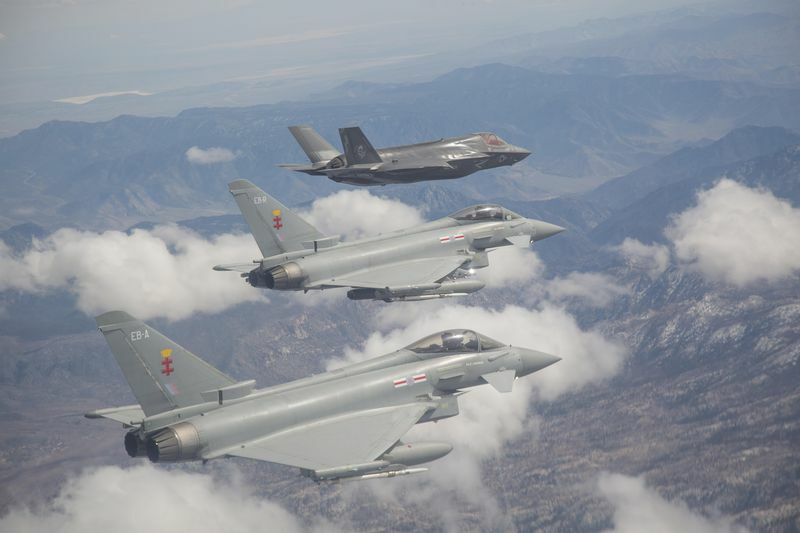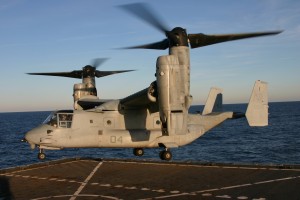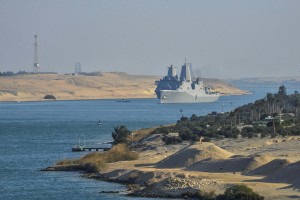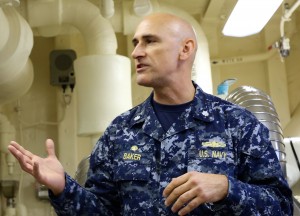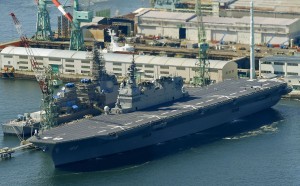2015-03-19 By Robbin Laird
The RAF is undergoing two fighter aircraft transitions at the same time.
On the one hand, the Tornado is being retired and the Typhoon is subsuming its missions. On the other hand, the F-35B is coming to the fleet and will be working with Typhoon for the period ahead.
These are three very different aircraft built in different periods of aviation history.
The venerable Tornado has seen a significant evolution over its time; from its initial use as an ultra low-level nuclear and unguided weapons bomber to an ISR-enabled precision strike and close support aircraft.
The Typhoon entered the RAF more than a decade ago as a classic air superiority fighter, but is now being asked to expand its effects and to subsume the Tornado missions.
The F-35B is entering the fleet as the Typhoon is making this transition.
This will mean that the RAF will be managing a double transition – Typhoon becoming multi-role and the F-35B operating off of land or ships to provide the fifth generation capability to the evolving RAF strike force.
The Complex Weapons Enterprise
A key enabler of the double transition is the weapons carried by the aircraft which allow for synergy of effects.
The UK Ministry of Defence (MoD) set in motion in the past decade an approach to shaping a weapons enterprise which is now bearing fruit and proving to be a key enabler of the double transition.
While the platform is clearly important, the MoD has acknowledged that there is no point in placing an aircraft in jeopardy if it can’t deliver the effects desired. As such, complex weapons have become a key part of UK integrated air power.
“Team Complex Weapons” has been described as follows on the MBDA website:
Team CW defines an approach to delivering the UK’s Complex Weapons requirements in an affordable manner that also ensures a viable industrial capacity with MOD being the architects of the sector strategy.
The first implementation of this approach is through the MOD–MBDA Portfolio Management Agreement, which has been independently evaluated as offering £1.2Bn of benefit to MOD over the course of the next 10 years.
This Agreement aims to transform the way in which CW business is conducted by MOD with its main supplier. At the heart of this is a joint approach to the delivery of the required capability based on an open exchange of information and flexibility in the means of delivery. It is therefore anticipated that the Agreement will be consistent with the future direction of acquisition reform within MOD and is well positioned to respond positively to the conclusions of the SDSR.
http://www.mbda-systems.com/innovation/team-complex-weapons/
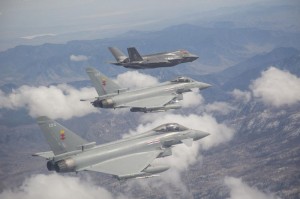
At the Farnbourgh Air Show in 2010, I attended a media briefing held by MBDA which provided a good overview on the Team CW approach.
The business model is of interest, not only for shaping a key ally’s approach to shaping future capability but in terms of being a potential harbinger for how MOD will handle efforts to maintain capabilities in the face of fiscal stringencies.
Lord Drayson in his formulation of the defense industrial strategy forged a number of initiatives, one of which was Team CW. The idea was to bring MOD into closer partnership with its weapons providers and supply chain to shape evolving capabilities in the industry with an eye to enhanced efficiencies but at the same time ensuring UK operational sovereignty in this key area of future military capability.
The baseline agreement was signed in June 2006 between MBDA, QinetiQ, Roxel and Thales UK as well as other members of the weapons supply chain to work with MOD in shaping development of future weapons. The idea has been to share risk, guide investment and clarify early for MOD what procurement choices are optimal for its point of view.
At the heart of the concept is to try to bridge the gap between industry and MOD in reducing risk and enhancing effective procurement. Obviously there are a number of challenges ranging for Intellectual Property ownership, investment sharing between government and diversity of private sector competitors to the question of the relationship between Team CW, MOD and the companies, such as Raytheon who are outside of the arrangement.
https://sldinfo.com/the-team-complex-weapons-business-model/
In other words, a key element of this double transition is enabled by the UK complex weapons enterprise. The UK MoD has created a close working relationship with industry to provide for the complex weapons necessary to enable the strike force.
And the fruits of this effort can be seen in the ability of weapons generated from this effort to empower the entire suite of fighters – Tornados, Typhoons, and Lightning IIs – to be able to reinforce their interactive capabilities.
The Tornado to Typhoon Transition
In this piece, I want to focus primarily upon the Tornado to Typhoon transition and the nature of that transition.
Adding a fifth generation capability is more than just a weapons issue, but the weapons dynamic is a key part of the overall integrative effort but will be the focus of attention in a later piece.
Group Captain Paul Godfrey, OBE has extensive experience of a range of combat aircraft through Harrier, F-16 and Typhoon. A Harrier weapons instructor, he was the first non-US national to fly the F-16 CJ operationally in the SEAD (Suppression of Enemy Air Defence) role whilst on exchange with the USAF and has spent the last 10 years in the Typhoon program with two flying tours including 4th/5th generation fighter training with the F-22.
After his current tour working on the Initial Operating Capability of the UK F-35B, he will become Station Commander RAF Lossiemouth, where two Typhoon squadrons are now located and a third will stand up in 2015. According to Group Captain Godfrey, a key impact of missile modernization on Typhoon will be to expand the effects of Typhoon operations.
“There is a clear need to expand the effects of Typhoon operations and here the enhancement of its weapons package will be an important improvement.”
The fast-approaching retirement of the Tornado is driving the weapons modernization program for the Typhoon. To enable Typhoon to assume Tornado’s roles, it is being reconfigured to provide an enhanced ground attack capability over and above the platform’s Enhanced Paveway II-only integration that was used by the RAF during the Libyan campaign.
First, Paveway 4 is being integrated followed by MBDA’s Storm Shadow and Dual-Mode Brimstone missiles, which have been deemed as the crucial elements of the Tornado to Typhoon transition. Thereafter the Typhoon’s capability will be supplemented with the turbo-jet powered long-range development of Brimstone, SPEAR 3, which will also be used on the F-35. This will close out the second phase of the RAF’s transition strategy.
Interestingly, the integration of the Storm Shadow on Typhoon is being driven in part by Saudi Arabia which wants its Typhoons to have a cruise missile carrying capability, and when married with its new air tanking capability can enhance the strike range of its Typhoon force.
The Dual-Mode Brimstone is designed to operate against maneuvering surface targets on land or sea.
It is a low collateral, close air support and anti-Fast Inshore Attack Craft weapon that has been combat proven by the RAF off Tornado in Afghanistan, Libya and Iraq. Clearly, it will greatly enhance the capability of the Typhoon.
Both Videos have been provided by the RAF and the first shows the Brimstone fired by a Tornado against an ISIS command vehicle; and the second video shows the Brimstone taking out a Libyan tank which was part of Qaddafi’s forces.
Importantly, in unison with its expanding air-to-ground capability, Typhoon’s air-to-air capability is also being enhanced with the integration of the new Meteor BVR missile, which allows for a broader range of offensive and defensive operations. The Meteor is a software upgradeable air-to-air missile with significant range and capability, which is being integrated on several other fourth generation aircraft – including Rafale and Gripen – as well as the fifth generation F-35s.
To gain a further sense of the transitional dynamics, I had a chance to talk with a retired RAF Tornado squadron leader who has been involved as well in the dynamics of Typhoon transition. This material was provided on background so the pilot will not be cited by name, but the key points of the discussion can be highlighted for an operator’s perspective is really central to understanding any significant airpower transition, which this one certainly is.
A key element of the transition, which was emphasized in the discussion, is not only the question of migration of missiles but of pilots.
As the Tornado force shrinks, Tornado pilots that move to the Typhoon are taking with them their mindset of how to support land forces, plus their hard-earned air-to-ground weapon experience honed over some 25 years of continuous combat operations.
“This cross-fertilization of ideas will allow the Typhoon force to do the roles that Tornado has always done. The only reason they can’t go all the way at the moment is because not all the weapons have been integrated onto the platform. Once the Typhoon weapon integration roadmap is complete, the Tornado can be taken out of service with the knowledge that the Typhoon force can accomplish everything Tornado can now and much, much more.”
He also emphasized the cross development of Tornado with Brimstone, which is a key weapon currently in used with great effect in Iraq.
As the Tornado’s precision weapon suite has increased, it has been able to play a more valuable close air support role. This change was first implemented in early Iraq operations, but changes brought about by lessons learned in Kosovo ensured that Tornado came of age.
“Brimstone started off as a fire-and-forget millimetric wave-only missile that was designed to destroy armor within a designated kill box. With the development of Dual-Mode Brimstone, which combines a semi-active laser seeker and a millimetric wave radar into a single missile, we are able to very accurately destroy mobile and fast maneuvering targets, as opposed to dropping multiple dumb bombs from altitude where the chances of hitting such a target are slim. The complex weapons that we’ve now put on Tornado have given that platform a new lease of life.”
Another key aspect of the weapons transition is that the Tornado crews are now able to employ a high load-out of mix-and-match weapons depending upon the operation and the expected target sets.
“The beauty of Tornado and its extensive weapon load-out is you can carry three Paveway 4s and three Dual-Mode Brimstones, or one Paveway 4 and six Dual-Mode Brimstones, or nine Dual-Mode Brimstones.
In Afghanistan and Iraq, our preferred weapon load-out is to carry two Paveway 4s and three Dual-Mode Brimstones.
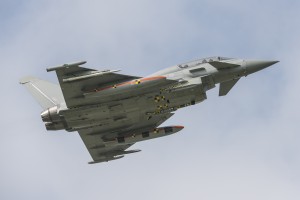
That way, you are equipped to engage effectively whichever target set presents itself.
While we have the Paveway 4 to take out static targets that require a 500-pound effect, the weapon of choice in Afghanistan and now in Iraq is the Dual-Mode Brimstone because there are so many moving targets and targets with collateral damage concerns that demand a small warhead.
Dual-Mode Brimstone-armed Tornados are therefore in great demand, especially so given that even the Americans are having real problems hitting such targets.
It was the same in Libya, where Tornado was the only platform allowed to go “down town” Misrata and Benghazi, and actually hit targets in the urban environment because of its 98% first shot hit rate.
This means that the Tornado force is not only the backbone of the Royal Air Force, but it delivers a unique capability on coalition operations too.
What the RAF is doing in the Tornado to Typhoon transition is bringing these skillsets and capabilities to the Typhoon now, and then expanding its capabilities further with the addition of Meteor and SPEAR 3. In other words, the Typhoon will possess game-changing capabilities that will guarantee its relevance even when the fifth generation Lightning II joins the UK’s combat air force mix.”
In short, the weapons enterprise is a key part of the Tornado to Typhoon transition which, in turn, will be further enabled by radar and other platform upgrades occurring in the Typhoon modernization program.
And while this transition is unfolding, the F-35 is also coming to the RAF and its closest airpower partner in that transition, the USMC.
Also, see the following:
https://sldinfo.com/what-do-the-eurofighter-and-f-35-have-in-common-the-meteor-missile/
https://sldinfo.com/the-f-35-and-legacy-aircraft-re-norming-airpower-and-the-meteor-example/
https://sldinfo.com/building-a-21st-century-weapon-the-case-of-the-meteor-missile/


